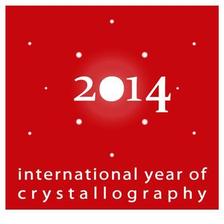International Year of Crystallography 2014
2014 was proclaimed as the International Year of Crystallography by the United Nations (UN). On Monday, the Science Year was officially launched at the headquarters of the UN Educational, Scientific and Cultural Organization UNESCO in Paris. “This year marks the centenary of the birth of modern crystallography,” UN Secretary-General Ban Ki-moon said in a message. “We celebrate 100 years of ground-breaking advances.”
There is hardly any field of natural sciences that can do without crystallography. DESY provides advanced and world-leading crystallography methods and with powerful X-ray light sources investigates a whole spectrum of materials ranging from innovative nano particles to medically relevant biomolecules. "Even though it permeates our lives, crystallography remains largely unknown," said UNESCO Director-General Irina Bokova, motivating the choice for this science year.
Crystallography investigates the inner structure of solid matter on the molecular and atomic level with the help of X-rays. A century ago, the German X-ray pioneer Max von Laue discovered the diffraction of X-rays by crystals. With these diffraction patterns, it is possible to calculate the inner structure of crystals. The British scientists William Henry Bragg and William Lawrence Bragg, father and son, utilised this finding to determine the inner structure of simple crystals – first of common salt, then of diamonds.
This opened up a completely new world for many fields of science, because with this knowledge it is not only possible to explore materials properties but also to tailor materials with the desired properties. For his discovery, von Laue was awarded the 1914 Nobel Prize in Physics and father and son Bragg were awarded in 1915.
"In the past 50 years, the structures of more than 90,000 biological molecules have been revealed by crystallographers, with great ramifications for health care," emphasised Bokova. One important example is the double helix structure of the DNA that was decoded with the help of crystallographic methods. “Today, scientists investigate complex structures with ultra-modern analysis methods using synchrotron radiation and X-ray lasers to understand the behaviour of materials and active ingredients at the molecular level,” said Professor Helmut Dosch, Chairman of the DESY Board of Directors.
No field of natural sciences – be it physics, chemistry, biology, medicine, mineralogy of materials sciences – is unaffected by crystallography, emphasised Professor Gautam Desiraju, President of the International Union of Crystallography (IUCr). The IUCr and the UNESCO jointly host the International Year of Crystallography and DESY belongs to the large circle of supporters. It operates two of the world’s best X-ray light sources for research and – together with international partners – currently builds the world’s best X-ray laser European XFEL. In 2012, DESY named its large X-ray experimental hall after Max von Laue. In the International Year of Crystallography, DESY plans to present several public lectures and an International Summer School of Crystallography for students at the Center for Free-Electron Laser Science will take place at DESY.
International Year of Crystallography: http://www.iycr2014.org
(from DESY News)







